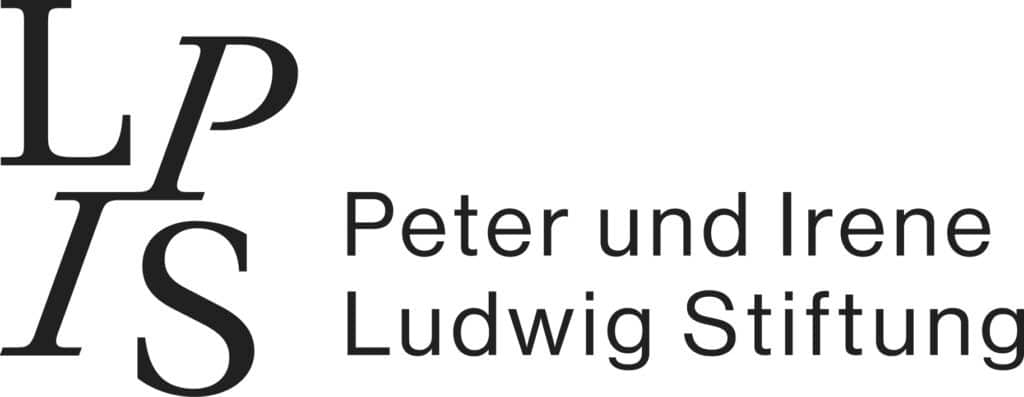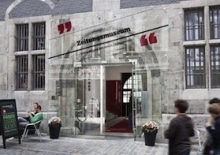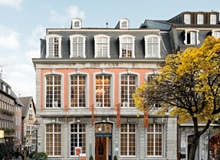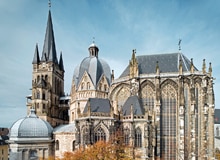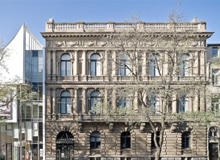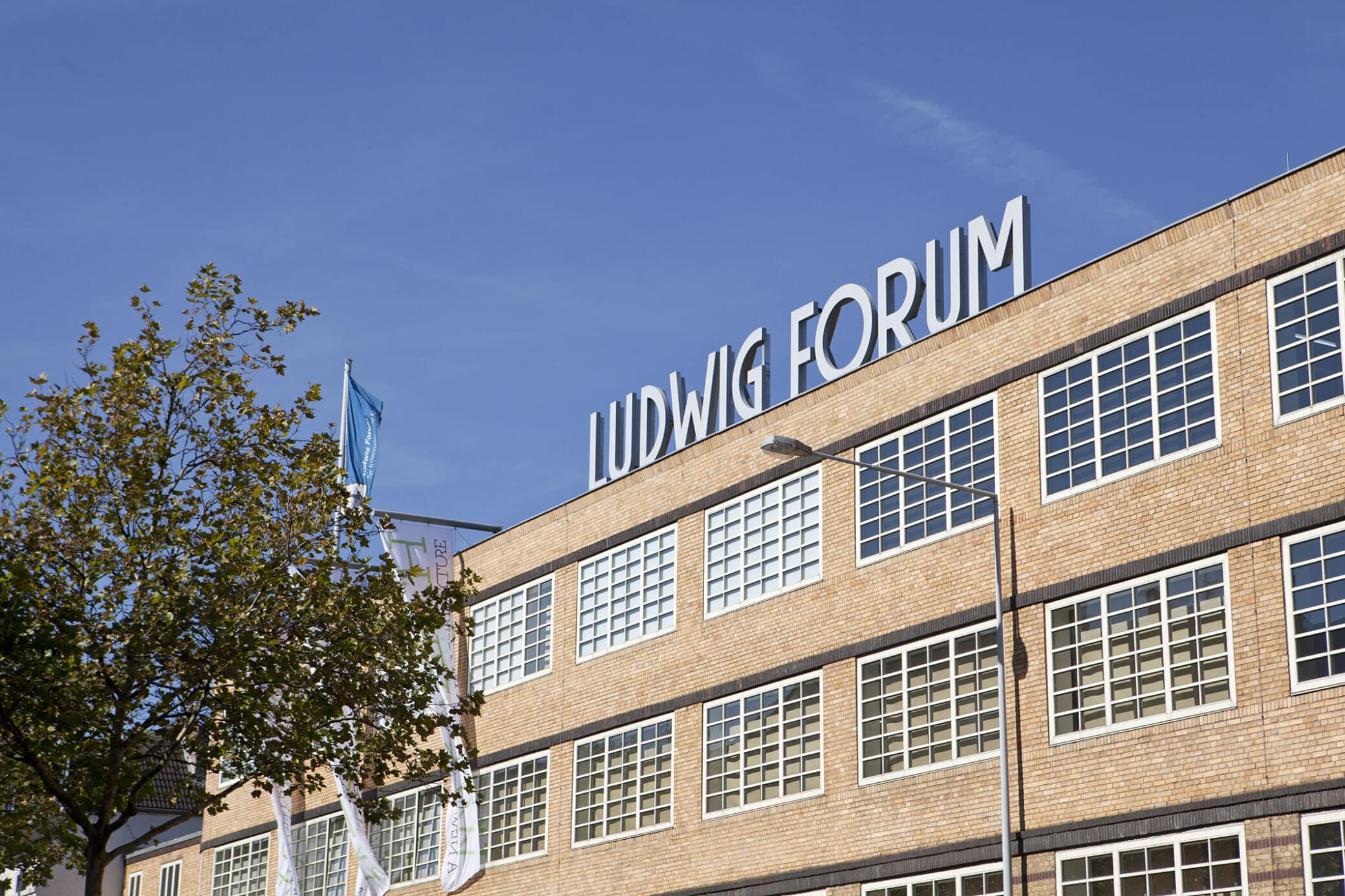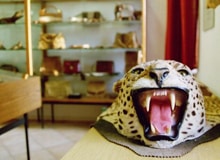Interfaces to culture
One of the key works in the collection of the Ludwig Forum that describe the transition from nature to culture is the painting “Einige landwirtschaftliche Geräte” (“Some Agricultural Tools”, 1983) by Julian Schnabel (*1951 in New York). On a sewn-together piece of canvas saturated with a reddish-brown earthy colour, Schnabel has fleetingly sketched two monumental icons. On the right, we see a sort of forked branch standing on edge that, with its cross struts and point, looks like a harrow, but could also be a primitive tent-like shelter or even a ship’s prow. On the left we can make out a device with a hint of wheels and an upward curving yoke which makes us think of a historic plough. With the allusions to wheel, tent and boat, Schnabel is using archaic symbols of the history of civilisation. With a few strokes he has sketched human evolution from nomads living in tents to the beginnings of agriculture, in which the art of sowing and planting was perfected through ongoing technological development. The wide arc of connotations ranges from symbols for primal cultural prototypes to the wheel as a metaphor for technological progress. At the same time, Schnabel takes us back to the roots of civilisation and reminds us that human culture owes its origin to cultivation, that what we call “culture” is nothing other than “agri-culture”.
Kcho (*1970 in Isla de Pinos, Cuba) and Thomas Virnich (*1957 in Eschweiler) also deal with the theme of simple devices made of natural materials. Virnich approaches an object with his typical 1980s technique by moulding it and translating it into different materials, for example taking a clay mould of a hollow tree stump and creating a clay vessel out of the natural shape that reminds us of primitive cultures. In contrast, with his “Machetenleiter” (“The Worst of Traps”, 1991), Kcho takes us back into the history of Cuba. What at first sight looks like a harmless climbing device that suggests the functional possibilities of a rope ladder, for example daring liberations, turns out on closer inspection to be a dangerous instrument of torture. The rungs are made of rusty blades of the sabre-like machetes used in colonial times by the slaves in Cuba to harvest the sugar cane. In this way, Kcho alludes to the bleak realities of the coloured population, but also of the peasants in Cuba and the inevitability of their fate.
In the paintings of Siron Franco (*1947 in Goiás, lives and works in São Paulo), Donald Baechler (*1956 in Hartford, Connecticut), László Fehér (*1953 in Székesfehérvár, Hungary) and Huang Yongping (*1954 in Xiamen, China), superficial tribute to original depictions of nature is used to visualise basic human feelings. Franco’s emblematically compact painting of a tapir resting in the coils of a snake stands for the delicate balance between the supposed peacefulness of nature and its latent danger. With its simple, almost childish imagery, Baechler’s “Wiener Wald” symbolises the loneliness of human existence. László Fehér paints the sandy plain surrounding the village of Tác as a seascape, and Huang Yongping collages a painting which, in the style of Millet, depicts a peasant woman resting in the fields in order draw attention to the urgent will to start over of a new generation in China at the beginning of the 1980s.
Nature and contemplation
Other works focus on the contemplative effect of nature and art, and the 15-meter-long stone path by Richard Long (*1945 in Bristol) is one of them. Half of the floor-work “Cornwall Carrara Line” (1988) is composed of small, smooth pebbles of white Carrara marble – the other of rough, jagged chunks of Cornish slate. Both types of stone strongly evoke the landscapes from which they originate. And so, an imaginary line is formed between the gentle, rolling hills of Tuscany and the rugged mountains of England. The flow of the floor-work suggests a journey from England to Italy. The careful positioning of the stones, reminiscent of Asian stone gardens, suggests a spiritually motivated pilgrimage, one dedicated to a quest for deeper insight.
In the three-panel painting by Michael Biberstein (*1948 in Solothurn, Switzerland), the theme is also a state of inner contemplation. A completely black monochrome surface on the left is followed by two canvases on which brown-green tones suggest a mountain landscape. As if veiled in mist, the scene seems to be in a process of flux and dissolution until, ultimately, only an indeterminate, intangible sense of vastness and sublime tranquility remains.
Absence of images is also a theme in Betty Leirner’s (*1959 São Paolo) short film “Two Lovers” (2000). With utter precision, it documents two cranes in the waters of the River Kamogawa near Kyoto serenely fishing and at the same time looking with interest at each other from a distance. That the film is black-and-white underlines the plain and unspectacular nature of the scene. The tranquility of the elegant birds, whose feet from time to time almost seem to caress the water, contrasts intensely with the constant motion of the endlessly flowing element, whose sparkles and reflections create vibrant shades of grey. The water seems unfathomable; all defined forms seem to dissolve. White bars blended in at intervals radicalise this process of dissolution and lead to a complete absence of images. Leirner’s so-called “Video Poem” is a metaphor for the relationship between life (the flowing current of the Kamogawa) and love (the consummate tranquility of the two cranes).
Gotthard Graubner (*1930 in Erlbach) and Joachim Bandau (*1936 in Cologne) go one step further in their works. While Bandau uses layer upon layer of thin coats of pigment to create deep black fields of colour with a cumulative potency, Graubner began in the early 1960s with his colour-saturated “cushion pictures”. His piece “Dark Blue Cushions” from 1963 indicates Graubner’s proximity to monochrome painters like, for example, Yves Klein. The volume of the painted cushions, their pulsating colour rhythm created through alternating intensities and dilutions, and their luminosity and spatial impact give Graubner’s “cushions” a physical presence and an almost haptic corporeality which set his work apart from other colour field painters.
From a distance, the painting “New Mexico, New York, #25” (1998) by Richard Tuttle (*1941 Rahway, New Jersey) looks like a panorama of mountain peaks. But from closer up, the monochrome grey-blue peaks set against a light blue background reveal themselves as an ingenious interplay of serrations and triangles. This work comes from a series of simple colour compositions on thin plywood, some of which feature an “overfold” that suggests an envelope or a casket containing a secret message. The shadow contours of the overfold work as lines or tints that correspond to the main colours of the painting. At the same time, these layers communicate with the surrounding space and – as in the interplay between spatial symmetry and the work form that quite obviously deviates from it – define the sophisticated dialectics of space and work of art.
Nature studies and scientific research
Other works reflect the tradition of the artist as a student of nature. One such artist is Tunga (*1952 Palmares, Brazil), who presents himself as an amateur researcher, insect lover and professional collector of fragrances. By means of the “Mistkäferschatzkiste” (Dung beetle’s treasure chest) (1992), which consists of three huge soap balls and three “Holy Scarabaeus of Tucurui” beetles, he tells the story of how, in the Northern Amazon Basin, he once captured these so-called “pill makers” using his own excrement and urine and how, during a longer journey, they processed the collection of his aromas into three head-sized balls, much to his surprise. Tunga interweaves reality and imagination, science and fantasy in an unfathomable way.
Next to his work we see murals by two representatives of German-French Nouveaux Realisme who in the 1960s, by using real things, sought to connect art and life. One exhibit is a cast-stone relief by Raoul Ubac (1910-1985, Malmedy), who joined the group of informalists led by Karl Fred Dahmen, Karl-Otto Götz and Ludwig Schaffrath in the early 1950s. Next to it hangs an object box by Karl Fred Dahmen (1917-1981, Stolberg/Rhineland), who was initially inspired by the Ecole de Paris and, from the mid-1960s, created material pictures into which he integrated a range of objects.
Two drawings and a bronze sculpture by Nancy Stevenson Graves (1940-1995, New York) document the interest of this American artist in the natural sciences. “Three snakes” (1971) looks like a botanical-zoological illustration that sketches and analyses the distinctive, arabesque movements of snakes. “Pleistocene camelus” (1971), a page on which a collection of bone finds are drawn, has the characteristic style of paleontological studies. This coloured drawing and the bronze sculpture of camel bones illustrate the passion this artist poured into the theme of “camels” from 1966 onwards. She was fascinated by their primeval shape, their expression of imperturbable calmness and their sheer endurance, and applied her knowledge of camels in a range of different artistic genres.
Next to the works of Nancy Graves hangs a painting by the Czech artist Martina Fojtü that depicts a collection of fauna as a biblical creation motif.
Micro and macro – structures in nature
The topic of micro- and macro-structures is addressed in the works of the two non-conformist artists Ivan Semenovič Čujkov (*1935 in Moscow, lives and works in Cologne and Moscow) and Olga Černyševa (*1962 in Moscow, lives and works in Moscow). In “Fragment auf Landschafts-Postkarte” (Fragment on a landscape postcard) (1987) Čujkov deals conceptually with the translation of a motif from nature in various forms, for example photography, panel painting and copying onto canvas, all of which go hand in hand with an alteration of proportions. In contrast, Černyševa paints her delicate landscape paintings on the sides of huge pieces of cake. The painting becomes part of a sculptural work that is intended to be a geometric form and at the same time a consumable ware.
Structures are depicted in the monumental woodcut “Großer Waldweg” (Big Forest Path) (2005/06) by Franz Gertsch (*1930 in Mörigen, Switzerland) and in “Mori Woods” (1987) by Shigeo Toya (*1947 in Nagano, Japan). The piece by Franz Gertsch, a leading representative of European photorealism, is impressive in its outstanding technical expertise. From 1986, Gertsch turned his attention to the technique of woodcutting and began a monumental series of still nature motifs. From a distance, the photographic origin of “Großer Waldweg” is still identifiable. But up close, the motif “disintegrates” into a multitude of the finest, filigree dots which divert the our attention to the laborious process of creation, i.e. the cutting of the colossal print block with the smallest gouges available.
“Mori”, as Toya called the series of installations he began in 1984, means “deep, dense forest” in Japanese. The 28 larger-than-life squared trunks, tapering towards the top, are erected in a right-angled field. The minimalist austerity of the arrangement contrasts strongly with the sumptuously elaborated and painted surfaces. These were artistically shaped at the top with axe and chainsaw, their many indentations and notches creating an impression of crystalline forms and fossil-like ossification, while the shafts with their ornamental, flowing shapes radiate a sense of living material. The direct contrasts of angular and organic shapes, wood and stone-like colouring, uniform sequencing and individual distinctiveness all create a dynamic field of tension in the installation. For Toya, and in the sense of Asian art tradition, nature consists of a canon of opposites, of rigidity and liveliness, of variety and homogeneity.
Ai Wei Wei (*1957 in Beijing), with a dadaistic feel for parody, creates a depiction of landscape that is “close to nature” – in the truest sense of the word – by stretching and mounting cowhide whose skin patterns evoke associations with a hilly landscape or an earth formation. Ira Joel Haber (*1947 in New York) creates what look like middle-class idylls in his boxes. These feature family homes hidden deep behind trees, inaccessible miniature worlds that betray something of the constriction and isolation of these supposed ideal worlds.
Eros and lust – elements of nature
Other works reflect on the voluptuousness and exuberance of nature, its playfulness and cheerfulness. “Asparagus” (1979), the animated film by Suzan Pitt (Los Angeles), is a characteristic example of this. With Suzan Pitt’s typical tongue-in-cheek pop imagery, the film deals with the driving forces of nature, and with eros as a source of artistic inspiration.
The works on paper of the artist Kim MacConnel (*1946 in Oklahoma City) bustle with watermelon ornaments and colourful fish and seafood. MacConnel is one of the pioneers of the “Pattern & Decoration” style. In the early 1970s he had already begun to take the colourful patterns of handicrafts of traditional cultures, as well as fruits and floral forms in the style of Southern French decorative arts, and to combine these with cartoon-like drawings.
Roy Lichtenstein (1923-1997, New York) invites the viewer to enter a summer riverscape with colourful sailing boats. Lichtenstein combines stylised, broad strokes of the brush from templates, the so-called “brushstrokes” he borrowed from comics in the 1960s, with gestural slashes of the brush. This loose painting style, vaguely reminiscent of impressionism, makes for a light and airy atmosphere.
Like Kim MacConnel, Brad Davis (*1942 in Duluth, Minnesota) also belongs to the “Pattern & Decoration“ movement. His radiant, light-yellow patchwork rondo shows a stylised blaze of tropical flowers. The artist Antonio Eligio Fernández Rodriguez Tonel (*1958 in Havanna) addresses the theme of dynamic nature in a different way. In his drawings, with their distinct ironic undertone, nature approaches either on foot or on wheels.
Journeys and routes
Works in which nature becomes the setting for contemplative journeys and other routes are thematically linked with Richard Long’s stone path, which depicts a journey of insight. The photographer William Wegman (*1943 in Holyoke, Massachusetts), famous for his bizarre dog portraits, is represented here with an unusual painting that depicts a placid riverscape with coach in a style of painting close to romanticism. This portrayal of a journey, which owes much to the 19th century, stands in contrast to two works by Peter Fischli & David Weiss (*1952 in Zürich/*1946 in Zürich). Their film “Der rechte Weg” (“The Right Way”, 1982/83) depicts the journey and philosophical observations on nature of the two artists, dressed in the costumes of a bear and a rat, as they make their way through Switzerland. In the same year, the Swiss duo of artists created the sculpture polyurathane sculpture “Der Auftrag” (“The Mission”, 1983). This piece takes the viewer on a trip to the centre of the earth and depicts life as a journey. On one side of the sculpture, all sorts of creatures loaded with heavy baggage push their way up a spiral staircase towards the surface of the earth, which is represented by green rolling meadows and little houses in bird’s-eye view. On the other side of the sculpture, the stone is a sort of “birthing chamber” with honeycomb forms full of eggs and larvae that, in a second stage of development as blue, hatched-out giant flies, crawl over red and blue beetles. While the one set of creatures follow their “inner mission” step by step and strive with enormous effort to reach the light of day, the colourful seething mass on the other side, unaffected and untroubled, pursues its own creaturely “agenda”, following the simple cycle of birth and death.
Natur/Kunst (Nature/Art) presents a selection of works in 2010 of 31 international artists from the Aachen Ludwig Collection who deal with the concept of “nature” in a range of different ways.
Curated by Dr. Annette Lagler
